| |
Gilead Drug Remdesivir: Rare Example of Foresight in the Pandemic
|
| |
| |
https://www.bloomberg.com/features/2020-gilead-remdesivir-coronavirus-treatment/
businessweek
Gilead Drug Remdesivir: Rare Example of Foresight in the Pandemic
By Robert Langreth
May 14, 2020
Emergency approval of the antiviral drug remdesivir is the first good news of this pandemic. This is how Gilead Sciences prepared for the moment.
By Robert Langreth
Photographs by Brian Guido for Bloomberg Businessweek
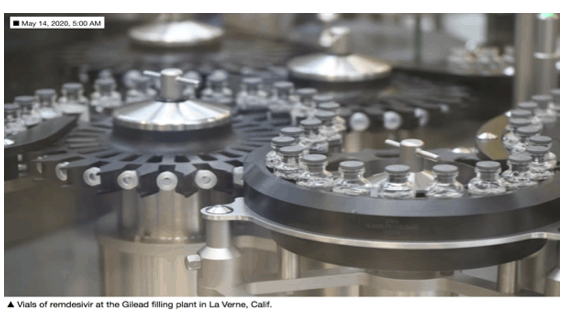
Last New Year's Eve, Tomas Cihlar, vice president for discovery virology at Gilead Sciences Inc., received a disturbing email from a top infectious diseases expert at the University of Virginia. The researcher had been working with Cihlar on a plan to test the Gilead drug remdesivir as a treatment for Middle East respiratory syndrome, a deadly disease caused by a coronavirus. MERS had been flaring up from time to time in Saudi Arabia and elsewhere since 2012, but this email was about something more ominous. There were cases of pneumonia suddenly emerging in Wuhan, China. Watch this one, the virologist warned. It might be a new coronavirus.
Remdesivir was one of the few experimental medicines that had shown promise in lab studies against a wide variety of coronaviruses. Like the rest of the world, Gilead knew next to nothing about this new one. The World Health Organization hadn't yet confirmed there was sustained human-to-human spread, and the extent of the outbreak in Wuhan wouldn't become clear for weeks. Nobody knew at that point whether it would become a pandemic, but Gilead started planning on the assumption it could. Within weeks, Chief Executive Officer Daniel O'Day formed a task force to study how to test remdesivir and, if it worked, mass-produce it.
Even by the exacting standards of pharmaceuticals, remdesivir is tricky to produce-the monthslong process involves 70 raw materials, reagents, and catalysts. The resulting active pharmaceutical ingredient, or API, is a white powder, 1.1 grams of which constitutes a single 10-day course of treatment. Remdesivir is administered intravenously, which introduces additional complexity into the manufacturing: The powder must be dissolved into a solution and then placed into glass vials under sterile conditions.

Thanks to its work on Ebola, Gilead already had a small supply of remdesivir on hand. Sitting in cold storage in Switzerland and California, were enough 30-milliliter vials of the drug to treat 5,000 people, which made it possible to begin human trials in the U.S., China, and elsewhere. In a factory in Edmonton, Alb., Gilead also had 100 kilograms of the bulk powder, perhaps enough to treat 90,000 patients.
To fill enough remdesivir vials to treat millions in a pandemic, however, would require a metric ton or more of the bulk drug. Gilead didn't have close to that-and still doesn't. So back in January it ordered more than a dozen of the most crucial starting materials and reagents from suppliers in China, Europe, and elsewhere. Gilead also helped its contractors locate sufficient supplies of compounds needed to make those starting materials.
There haven't been a lot of stories of foresight and preparedness in this pandemic. This is one. After a big trial sponsored by the National Institute of Allergy and Infectious Diseases, remdesivir was authorized on May 1 for emergency use on Covid-19, the disease caused by the new coronavirus. Anthony Fauci, the director of the NIAID, has likened the trial of remdesivir to the first big trial of AZT, the first drug for HIV. As AZT was, remdesivir is being authorized for wide use before it's fully clear how effective it will be. Preliminary data from the 1,063-person trial show the medicine sped recovery in the most serious cases of Covid-19 by about four days. Full details haven't been published, and a smaller trial in China didn't find a benefit. The Food and Drug Administration, in granting the emergency authorization, didn't allow Gilead to claim the drug is safe and effective for Covid-19; the agency said only that it's reasonable to believe the medicine may help.
"It is not a cure," O'Day says. "It is a first step, but it is an important first step." Many additional drugs and vaccines will probably be needed to stop the pandemic, he says. Gilead itself is working on an easier-to-administer inhaled form of remdesivir that might be useful for less severe cases.
But with few other medicines available and the number of Covid-19 cases continuing to grow steadily-about 4.3 million cases and 290,000 deaths at press time-the drug is likely to be in high demand until a better treatment or a vaccine is available. Gilead plans to donate the first 1.5 million vials, enough for roughly 200,000 patients. (The number depends on the dosage: The emergency use authorization allows both a 10-day course of treatment for patients on ventilators and a 5-day course for those not on ventilators.) Those will be delivered this spring. By the fall a much larger supply should start to become available, and Gilead is also working with other, unnamed companies to bring new factories online overseas. The question is, can Gilead make enough of it for the whole world?
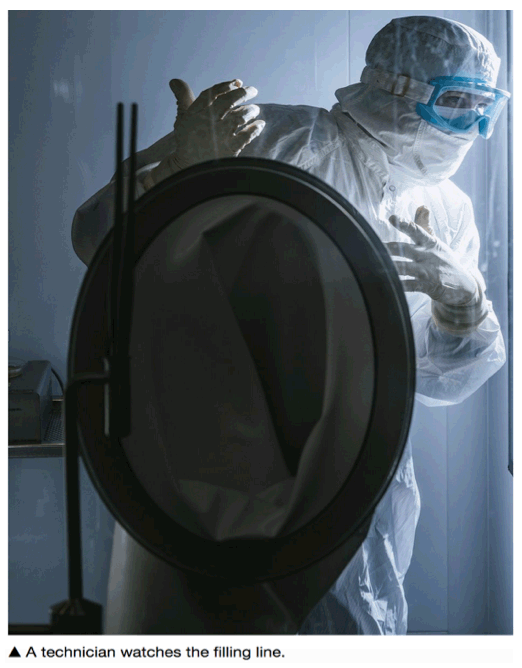
Gilead, based in Foster City, Calif., is the most successful maker of antiviral drugs in history. The company was founded in 1987, and early on its chemists invented the influenza drug Tamiflu. In the 2000s it started packaging multiple powerful anti-HIV medicines into simple once-a-day pills, replacing complicated multi-pill regimens. In 2013 it came out with Sovaldi, a breakthrough drug for hepatitis C. The news was overshadowed, initially, by a furor over the price: $1,000 a pill. As cheaper competing drugs hit the market, Gilead's hep C revenue declined. Wall Street hasn't cared for that and has pressured Gilead to expand beyond antivirals into faster-growing arenas such as cancer treatments.
Until January, there wasn't much reason for a drug company to work on coronaviruses. For years they were considered mere nuisances, responsible mostly for many common colds. The first deadly human disease caused by a coronavirus, severe acute respiratory syndrome, or SARS, was stopped in 2003, before it gained a significant foothold in the human population. The next deadly coronavirus, MERS, doesn't spread efficiently in humans. The virus that causes Covid-19 is more closely related to SARS, so much so that its official designation is SARS-CoV-2.
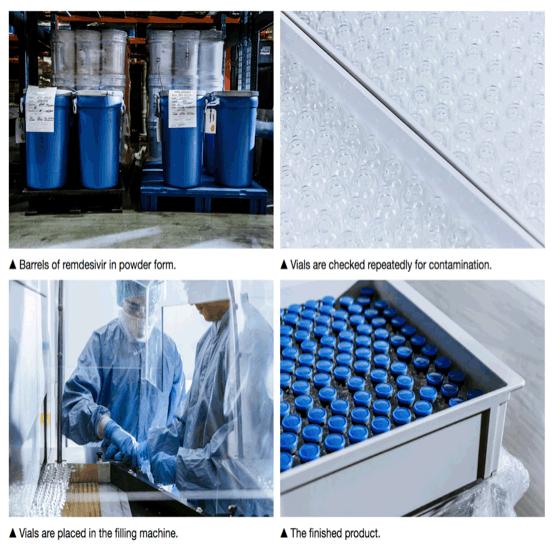
A precursor to remdesivir was developed in 2009 by Gilead chemists hunting for hepatitis C drugs. It was difficult to administer, however, and Gilead had more promising drugs for hep C, in pill form, so it mostly sat on the shelf for several years. But in studying the compound, Gilead scientists showed in the test tube that it could slow the replication of a broad number of viruses.
During the Ebola outbreak in West Africa in 2014, Gilead put together a team of scientists to look at whether any of its existing drugs could help treat it or other emerging viruses. Remdesivir quickly moved to the top of the list. By mid-2015, working with government scientists, Gilead had shown the drug worked against Ebola in laboratory animals and begun human safety trials. But by the time remdesivir was ready for human efficacy trials, the Ebola outbreak was fading.
During the same period, Gilead was invited to participate in a government-sponsored consortium of academic researchers working on possible drugs for emerging viruses. Two virologists in this group, Mark Denison of Vanderbilt University Medical Center and Ralph Baric of the University of North Carolina at Chapel Hill, had worked together on coronaviruses for years. Baric first warned about the potential for them to cause significant human disease back in the late 1990s.
Denison was skeptical the Gilead compounds would do much. But when he tested an analog of remdesivir against a mouse coronavirus in his lab, it worked. Over the next few years, Baric and his UNC colleague Timothy Sheahan tested the drug against SARS virus, MERS virus, and numerous other bat coronaviruses. Remdesivir worked better than almost any other drug they tried. "Every virus we tested it on, it had very high potency and efficacy," Denison recalls.
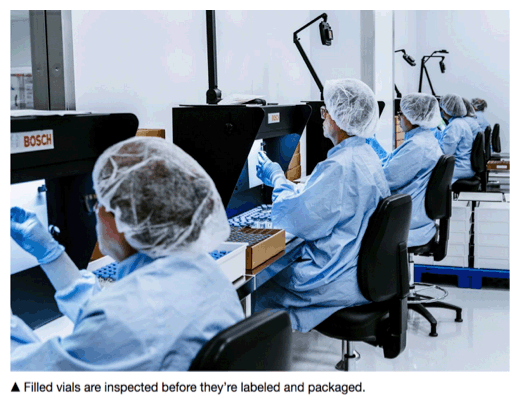
In 2018 another Ebola outbreak flared up in the Congo, giving Gilead an opportunity to finally test remdesivir in people with Ebola. It didn't work. But the trials proved one thing: The drug was safe. Gilead was figuring out what to do with the compound next, says Cihlar, when Covid-19 came along.
Ken Kent, Gilead's vice president in charge of chemical development and manufacturing, compares drug manufacturing to baking giant quantities of a very complicated bread: You have to perform all the right steps in precisely the right sequence. And just as a baker needs a particular flour to make a signature bread, a pharmaceutical chemist must have sufficient quantities of all the right ingredients on hand. "If you have to wait for the wheat to grow," Kent says, "it's going to take a while."
Kent joined Gilead in the late 1980s-he was employee No. 8-and has been involved in one way or another with many of its antiviral hits, including Tamiflu, Sovaldi, and Truvada, a big-selling prophylactic HIV drug combination. Today he's in charge of producing the active ingredients for all of Gilead's "small-molecule" drugs. That's industry jargon for pills and other medicines made through traditional chemistry, as opposed to DNA- or protein-based concoctions, which are produced using genetic engineering and brewed inside living cells. While remdesivir isn't a pill, it is a smaller molecule.
In mid-January, Kent got a call from Reza Oliyai, senior vice president for Gilead's pharmaceutical operations, telling him the company would need to make large quantities of remdesivir to fight the novel coronavirus. Kent immediately started calculating how long that would take. "We had to move quick, because the one thing you can't buy is time," he says. "When you have long linear chemical synthesis, that has to be done sequentially A to B to C, that's time you just can't get back."
Gilead says it's simply too soon to talk about price. Wall Street doesn't think so
Depending on how you count, there are about 25 chemical steps in the production process. Most drugs require about half that number. Some of the steps are more delicate than others. An early one uses a reagent so flammable it will spontaneously combust if exposed to air. Another involves a poison called trimethylsilyl cyanide. "If you get it on your body you better get yourself to the hospital really quick," says Howard University chemist Joseph Fortunak, who's analyzed the remdesivir manufacturing process. "And you still might not survive."
Kent estimated that without improvements in the process it would take 9 to 12 months to make a batch of remdesivir from scratch. That included a few months for suppliers scattered around the world to make the raw ingredients, six months for Gilead to assemble those ingredients into the precious powder, and a final month to finish and package the drug at the filling plant in La Verne, Calif.
This calculation led Kent and Oliyai to brief O'Day on the need to order more raw ingredients and other supplies right away to prevent bottlenecks. O'Day signed off immediately, Kent says. At the same time, Kent assembled a team of 20 chemists who started working on ways to speed up the manufacturing process on both the remdesivir powder made in Edmonton and the starter chemicals made by Gilead's contractors. Eventually they instituted tweaks that reduced the time to manufacture the drug to six months.
On Feb. 2, Gilead flew the powder left over from its Ebola effort-100 kilograms packed in high-density polyurethane drums with tamper-evident seals-from Edmonton to La Verne. At the filling plant, the powder was mixed with sterile water and excipients (substances that enhance the powder's solubility) in reaction vessels, then passed through another filtration step to ensure sterility. An automated filling machine put it in vials. After two weeks of sterility testing, labels were prepared and checked.
The Edmonton plant also had enough raw materials to start on another batch of powder in its glass-lined steel reactors. This batch, enough for at least 30,000 patients, was completed by early April. Soon after, the massive order of supplies Gilead had placed in January started to arrive by plane, allowing workers to start producing far larger batches of the drug. Those will begin shipping to the California filling plant in June, Gilead says. A contract manufacturer in Iowa will also start releasing batches of remdesivir in August, and the company has begun to assemble a consortium of chemical and pharmaceutical manufacturers in India, Pakistan, and elsewhere to help supply the rest of the world.
The U.S. Department of Health and Human Services recently announced that 607,000 of the initial 1.5 million vials of remdesivir will be distributed domestically-enough for about 78,000 patients. That leaves enough of the drug for about 115,000 non-U.S. patients. If the pandemic is still raging when the supply of donated drugs runs out, and if vaccines or better treatments still aren't available, there will be a furious debate about the price. Gilead says it spent $50 million on the drug in the first quarter of the year and could spend as much as $1 billion by yearend, mostly on manufacturing but also potentially on additional clinical trials.
O'Day says that Gilead is committed to making sure the medicine is accessible and affordable to patients around the world and that it's simply too soon to talk about price. Wall Street doesn't think so. Analysts are already pressing him on how his company will make money from remdesivir.
"What is special about Covid?" Geoffrey Porges, an analyst at the investment bank SVB Leerink LLC, asked O'Day on an April 30 earnings call. "Should we assume the returns are going to be similar to the returns you have generated in other parts of the business?" Porges later explains that he views a pandemic as exactly the time a drug breakthrough should pay off big. "The 50th medicine for blood pressure we are allowing them to make a profit on, but protecting the world from a pandemic-you can't make a profit on that?" he says. "It is crazy. It should be the opposite."
Other analysts have estimated the price could be $3,000 to $5,000 per treatment, in line with other new drugs to treat infections in hospitalized patients. At that price remdesivir could generate $1 billion or more in annual sales, if it ends up being used by hundreds of thousands of people.
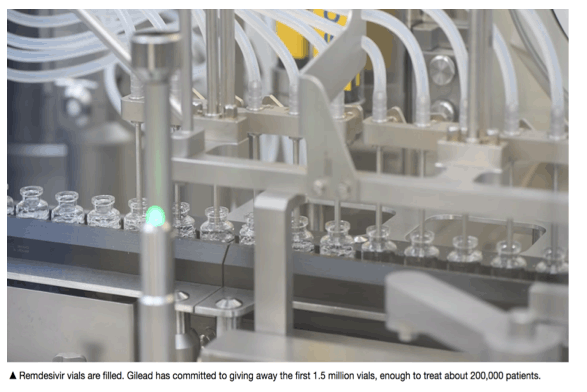
While the drug is complicated to make, it won't necessarily be expensive to produce on a per-person basis once production is scaled up and manufacturing efficiencies are maximized. In April scientists at the University of Liverpool and Howard University estimated that generics manufacturers could produce remdesivir for just $9 per dose, according to a study published in the Journal of Virus Eradication.
Gilead's shares are up 22% this year, and investors expect the company will eventually earn a return on its most high-profile drug, assuming the drug is still needed. At the same time, activists pushing for a low cost are pointing out the government's key role in identifying remdesivir's potential for treating coronaviruses. Public Citizen says the U.S. government has spent at least $70.5 million funding research on the possible uses of the drug.
In the best case scenario that everyone is hoping for, vaccines now in early trials will work well, halt the virus's spread, and render drugs like remdesivir largely obsolete. Even if that happens, Gilead's pricing decision on remdesivir may have a lasting impact. As the first drug in a new category, it may set a precedent for other Covid-19 treatments. The coronavirus has already caused untold economic damage, leading to the highest U.S. unemployment rate since the Great Depression. And the virus looks like it isn't going away. Vaccines and drugs for Covid-19 may be needed for years to come. We could spend years asking how much society is willing to pay for a cure. -With Susan Berfield
|
|
| |
| |
|
|
|